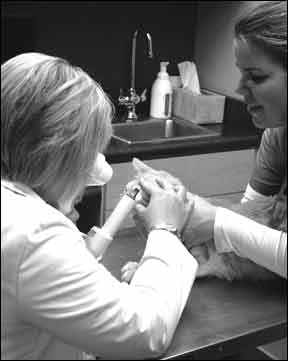The eye is an amazing, delicate organ. Cells within the eye normally produce a clear fluid (aqueous humor) that serves to nourish and maintain the shape of the eye. When the balance between the production and the drainage of fluid is upset, glaucoma can result. Decreased drainage of fluid causes increased pressure (and pain) within the eye, often resulting in damage to the optic nerve and, consequently, loss of vision.

288
While glaucoma is much less common in cats than in dogs, it still poses the same high risk of blindness if left untreated. In fact, even if diagnosed early on, treatment is not always successful.
The Two Types. There are two main categories of glaucoma: primary and secondary. According to Thomas Kern, DVM, an associate professor of ophthalmology at Cornell University’s College of Veterinary Medicine who is board-certified by the American College of Veterinary Ophthalmologists, primary (inherited) glaucoma is uncommon in cats; it involves a structural problem with the filtration (drainage) angle. Secondary glaucoma develops because of another disorder already present in the eye; that is, there is a problem within the eye which causes a disruption in the necessary drainage of fluid. The most common causes of secondary glaucoma are inflammation, lens luxation, tumors and trauma. Inflammation inside the eye becomes a problem because protein and debris begin circulating in the aqueous humor and can plug the filtration angle. Many things can cause the eye to become inflamed — some of which are never identified.
However, feline leukemia virus (FeLV), feline immunodeficiency virus (FIV), feline infectious peritonitis (FIP) and toxoplasmosis all affect the immune system’s ability to ward off infection, thereby making it much easier for a cat to develop uveitis (inflammation of the eye). Lens luxations (dislocations) generally occur in tandem with chronic uveitis. Chronic inflammation can cause the fibers that hold the lens in place to break down; if the lens falls into the front chamber of the eye, it can disrupt the drainage of fluid from the eye. Tumors within the eye can block the filtration angle. And injury to the eye can cause blood to pool inside, plugging the filtration angle.
How It’s Treated. Treatment of glaucoma can be difficult and expensive and may be necessary throughout the cat’s remaining lifetime. However, vision can sometimes be saved if the treatment begins soon enough. When treating glaucoma, it is important to eliminate any underlying disorders that may be causing a problem within the eye.
Secondly, pressure must be reduced to avoid further damage to the optic nerve. Treatment can be medical or surgical. Medical treatment is often used in cases where inflammation is the culprit. Medications that reduce inflammation and decrease the production of fluid are typically administered. Surgical treatment may be necessary if the cat is unresponsive to medical treatment or if the glaucoma is caused by lens luxation, a tumor or trauma. In the case of a dislocated lens, the lens may be removed manually. Goniovalve insertion — surgical implantation of a tube to allow proper fluid drainage — may also be an option in order to relieve pressure within the eye.
Unfortunately, once a tumor is present or vision has already been lost, it is often necessary to remove the eye, a procedure called enucleation. However, cats are extremely adaptable and can continue to lead happy, satisfying lives even without perfect vision.
What You Shoul Look For. Many signs of glaucoma may be either barely perceptible or easily confused with other disorders. If any of the following symptoms are observed, it is important to seek veterinary care as soon as possible:
– bloodshot eye;
– very squinty, apparently painful eye
excessive tearing;
– dilated pupil that is unresponsive to changes in light;
– cloudy cornea;
an enlarged appearance of the eye
vision loss;
– lethargy, irritability and a decrease in appetite, which may be responses to the discomfort or pain of increased pressure within the eye.
The best defense against glaucoma and vision loss is preventative care and early detection. According to Dr. Kern, it may be beneficial, especially for geriatric cats, to have regular ophthalmic examinations. As with any health issue, it pays to be finely attuned to your cat’s behavior and appearance.



